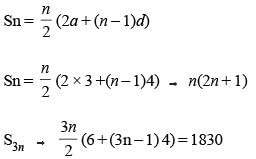CAT Exam > CAT Questions > Let a1, a2...., a2n be an arithmetic progress...
Start Learning for Free
Let a1, a2...., a2n be an arithmetic progression with a1 = 3 and a2 = 7. If a1 + a2 + ... + a3n = 1830, then what is the smallest positive integer m such that m(a1 + a2 + ... + an) > 1830?
(2017)
- a)8
- b)9
- c)10
- d)11
Correct answer is option 'B'. Can you explain this answer?
Most Upvoted Answer
Let a1, a2...., a2n be an arithmetic progression with a1 = 3 and a2 = ...
The general term of the arithmetic sequence can be written as an = a1 + (n-1)d, where a1 = 3 is the first term and d is the common difference.
We can find the common difference by subtracting the first term from the second term:
d = a2 - a1 = 7 - 3 = 4.
Now we can find the value of n by using the formula for the sum of an arithmetic series:
Sn = n/2 * (a1 + an)
Substituting the given values, we have:
1830 = n/2 * (3 + a1 + (n-1)d)
1830 = n/2 * (3 + 3 + (n-1)4)
1830 = n/2 * (6 + 4n - 4)
1830 = n/2 * (2n + 2)
Dividing both sides by 2:
915 = n * (n + 1)
Now, we want to find the smallest positive integer m such that m(a1 + a2 + ... + an) is divisible by 3. Since the sum of an arithmetic series is given by Sn = n/2 * (a1 + an), we want to find the smallest positive integer m such that m * Sn is divisible by 3.
Since Sn = n/2 * (3 + a1 + (n-1)d), we want to find the smallest positive integer m such that m * (n/2 * (3 + a1 + (n-1)d)) is divisible by 3.
Dividing both sides of the equation 915 = n * (n + 1) by 3, we get:
305 = n * (n + 1)/3
This means that n * (n + 1)/3 is an integer, so either n or (n + 1) must be divisible by 3.
Since we want to find the smallest positive integer m, we want to find the smallest n that satisfies this condition.
n = 17 satisfies the condition, because 17 is not divisible by 3, but (17 + 1) = 18 is divisible by 3.
Therefore, the smallest positive integer m such that m * (a1 + a2 + ... + an) is divisible by 3 is m = 18.
Therefore, the smallest positive integer m such that m * (a1 + a2 + ... + an) is divisible by 3 is m = 18.
We can find the common difference by subtracting the first term from the second term:
d = a2 - a1 = 7 - 3 = 4.
Now we can find the value of n by using the formula for the sum of an arithmetic series:
Sn = n/2 * (a1 + an)
Substituting the given values, we have:
1830 = n/2 * (3 + a1 + (n-1)d)
1830 = n/2 * (3 + 3 + (n-1)4)
1830 = n/2 * (6 + 4n - 4)
1830 = n/2 * (2n + 2)
Dividing both sides by 2:
915 = n * (n + 1)
Now, we want to find the smallest positive integer m such that m(a1 + a2 + ... + an) is divisible by 3. Since the sum of an arithmetic series is given by Sn = n/2 * (a1 + an), we want to find the smallest positive integer m such that m * Sn is divisible by 3.
Since Sn = n/2 * (3 + a1 + (n-1)d), we want to find the smallest positive integer m such that m * (n/2 * (3 + a1 + (n-1)d)) is divisible by 3.
Dividing both sides of the equation 915 = n * (n + 1) by 3, we get:
305 = n * (n + 1)/3
This means that n * (n + 1)/3 is an integer, so either n or (n + 1) must be divisible by 3.
Since we want to find the smallest positive integer m, we want to find the smallest n that satisfies this condition.
n = 17 satisfies the condition, because 17 is not divisible by 3, but (17 + 1) = 18 is divisible by 3.
Therefore, the smallest positive integer m such that m * (a1 + a2 + ... + an) is divisible by 3 is m = 18.
Therefore, the smallest positive integer m such that m * (a1 + a2 + ... + an) is divisible by 3 is m = 18.
Community Answer
Let a1, a2...., a2n be an arithmetic progression with a1 = 3 and a2 = ...
a1 = 3, a2 = 7, d = 4

n(6n + 1) = 610
6n2 + n - 610 = 0
solved, n = 10
Now, m(a1 + a2 + ... an) > 1830

m > 8.7 → m > 9

n(6n + 1) = 610
6n2 + n - 610 = 0
solved, n = 10
Now, m(a1 + a2 + ... an) > 1830

m > 8.7 → m > 9

|
Explore Courses for CAT exam
|

|
Similar CAT Doubts
Question Description
Let a1, a2...., a2n be an arithmetic progression with a1 = 3 and a2 = 7. If a1 + a2 + ... + a3n = 1830, then what is the smallest positive integer m such that m(a1 + a2 + ... + an) > 1830?(2017)a)8b)9c)10d)11Correct answer is option 'B'. Can you explain this answer? for CAT 2025 is part of CAT preparation. The Question and answers have been prepared according to the CAT exam syllabus. Information about Let a1, a2...., a2n be an arithmetic progression with a1 = 3 and a2 = 7. If a1 + a2 + ... + a3n = 1830, then what is the smallest positive integer m such that m(a1 + a2 + ... + an) > 1830?(2017)a)8b)9c)10d)11Correct answer is option 'B'. Can you explain this answer? covers all topics & solutions for CAT 2025 Exam. Find important definitions, questions, meanings, examples, exercises and tests below for Let a1, a2...., a2n be an arithmetic progression with a1 = 3 and a2 = 7. If a1 + a2 + ... + a3n = 1830, then what is the smallest positive integer m such that m(a1 + a2 + ... + an) > 1830?(2017)a)8b)9c)10d)11Correct answer is option 'B'. Can you explain this answer?.
Let a1, a2...., a2n be an arithmetic progression with a1 = 3 and a2 = 7. If a1 + a2 + ... + a3n = 1830, then what is the smallest positive integer m such that m(a1 + a2 + ... + an) > 1830?(2017)a)8b)9c)10d)11Correct answer is option 'B'. Can you explain this answer? for CAT 2025 is part of CAT preparation. The Question and answers have been prepared according to the CAT exam syllabus. Information about Let a1, a2...., a2n be an arithmetic progression with a1 = 3 and a2 = 7. If a1 + a2 + ... + a3n = 1830, then what is the smallest positive integer m such that m(a1 + a2 + ... + an) > 1830?(2017)a)8b)9c)10d)11Correct answer is option 'B'. Can you explain this answer? covers all topics & solutions for CAT 2025 Exam. Find important definitions, questions, meanings, examples, exercises and tests below for Let a1, a2...., a2n be an arithmetic progression with a1 = 3 and a2 = 7. If a1 + a2 + ... + a3n = 1830, then what is the smallest positive integer m such that m(a1 + a2 + ... + an) > 1830?(2017)a)8b)9c)10d)11Correct answer is option 'B'. Can you explain this answer?.
Solutions for Let a1, a2...., a2n be an arithmetic progression with a1 = 3 and a2 = 7. If a1 + a2 + ... + a3n = 1830, then what is the smallest positive integer m such that m(a1 + a2 + ... + an) > 1830?(2017)a)8b)9c)10d)11Correct answer is option 'B'. Can you explain this answer? in English & in Hindi are available as part of our courses for CAT.
Download more important topics, notes, lectures and mock test series for CAT Exam by signing up for free.
Here you can find the meaning of Let a1, a2...., a2n be an arithmetic progression with a1 = 3 and a2 = 7. If a1 + a2 + ... + a3n = 1830, then what is the smallest positive integer m such that m(a1 + a2 + ... + an) > 1830?(2017)a)8b)9c)10d)11Correct answer is option 'B'. Can you explain this answer? defined & explained in the simplest way possible. Besides giving the explanation of
Let a1, a2...., a2n be an arithmetic progression with a1 = 3 and a2 = 7. If a1 + a2 + ... + a3n = 1830, then what is the smallest positive integer m such that m(a1 + a2 + ... + an) > 1830?(2017)a)8b)9c)10d)11Correct answer is option 'B'. Can you explain this answer?, a detailed solution for Let a1, a2...., a2n be an arithmetic progression with a1 = 3 and a2 = 7. If a1 + a2 + ... + a3n = 1830, then what is the smallest positive integer m such that m(a1 + a2 + ... + an) > 1830?(2017)a)8b)9c)10d)11Correct answer is option 'B'. Can you explain this answer? has been provided alongside types of Let a1, a2...., a2n be an arithmetic progression with a1 = 3 and a2 = 7. If a1 + a2 + ... + a3n = 1830, then what is the smallest positive integer m such that m(a1 + a2 + ... + an) > 1830?(2017)a)8b)9c)10d)11Correct answer is option 'B'. Can you explain this answer? theory, EduRev gives you an
ample number of questions to practice Let a1, a2...., a2n be an arithmetic progression with a1 = 3 and a2 = 7. If a1 + a2 + ... + a3n = 1830, then what is the smallest positive integer m such that m(a1 + a2 + ... + an) > 1830?(2017)a)8b)9c)10d)11Correct answer is option 'B'. Can you explain this answer? tests, examples and also practice CAT tests.

|
Explore Courses for CAT exam
|

|
Signup to solve all Doubts
Signup to see your scores go up within 7 days! Learn & Practice with 1000+ FREE Notes, Videos & Tests.






















